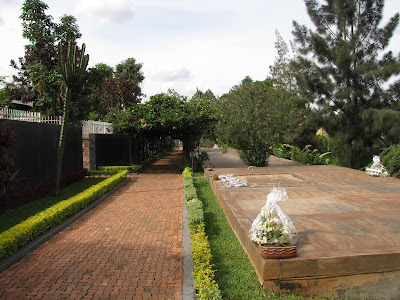The events leading up the genocide are complex, but are rooted in the demeaning and disgusting colonial policies of the Belgian government, which purposely segregated the population of Rwanda and set them against each other to further their own economic goals. That, coupled with French political meddling and arms deals made Rwanda a veritable powder keg by the second half of the 20th century. Add in a few depraved military and political leaders and all the ingredients were there for a human tragedy of unfathomable dimensions. In just 100 days nearly one million men, women, and children were killed while the global community pointedly ignored the tragedy.
On Monday we visited two sites that are memorials to the genocide of 1994. The first was a former Rwandan army barracks where 10 Belgian UN peacekeepers were killed. They were assigned by the UN Assistance Mission in Rwanda (UNAMIR) to protect Prime Minister Agathe Uwilingiyimana. After she was assassinated, the Belgians were killed in the classroom where they were held after surrendering. The UN mandate prevented the soldiers from using force unless they were fired upon.
 |
| The outside of the building, riddled with bullet holes from where the radical Rwandan governmental forces opened fire. |
Our second stop was at the Kigali Genocide Memorial. This memorial was built to serve as a resting place for victims of the genocide and as a means to share the story of the genocide with the goal of preventing such tragedies in the future. As you can well imagine, visiting the memorial was a tremendously powerful and sobering experience. There were three areas within the museum. The first tells the story of the Rwandan genocide from pre-colonial times through reconciliation. The second area serves to highlight other genocides with the goal of furthering understanding of the causes of such events. I did not visit the third area - Rwanda's children and the genocide. I could simply not handle it emotionally. As much as I want to learn and pay respect to the victims by hearing their stories, I was honestly afraid of becoming physically sick if I faced what happened to those beautiful, innocent children.
 |
| The Kigali Genocide Memorial, viewed from the Children's Garden. |
 |
| 250,000 Rwandans are buried in the crypts at the memorial, on the right side of this photo. Many flowers are left at the site, some bearing the names of loved ones lost in the genocide. |
This is not easy history. It hurts. A lot. Yet this is history that we should all know lest it happen again.
Once the overwhelming sadness passed, the very next feelings I had were hope and a true admiration for the people of Rwanda, who have made amazing strides to reconcile with one another and move past the horrific events of 1994. There are no longer Hutus and Tutsis. There are only Rwandans.


No comments:
Post a Comment